At the London Orthotic Consultancy, we have been treating patients with scoliosis since 2017.
During that time, we have treated a broad range of patients with mild to severe curves, from 3 years old to 80 years old.
Many of our patients, even those with severe scoliosis (Cobb angles over 40 degrees), have responded well to the combined treatment of the LOC Scoliosis Brace (a Cheneau-Gensingen derivative Brace) and Schroth therapy.
Below you can see some of our patient case histories which, in the case of our younger patients, parents have kindly given us permission to publish.
Treatment type: LOC Scoliosis Brace, Schroth therapy
Mountain climber Matilde's scoliosis journey began in 2022, diagnosed in Chile with a 29-degree Cobb angle. Limited by traditional braces, her family, led by medical insight from her father Felipe, sought more advanced solutions.
After travelling to the London Orthotic Consultancy (LOC) clinic in Kingston, Matilde's journey took a transformative turn. Under Anna Courtney's guidance, she embraced the corrective LOC Scoliosis Brace, supplemented by Schroth therapy.
In just four months, Matilde's Cobb angle reduced from 29 to 14 degrees, a testament to the brace's efficacy and her dedication to the accompanying exercise programme.
Read Matilde's scoliosis bracing story
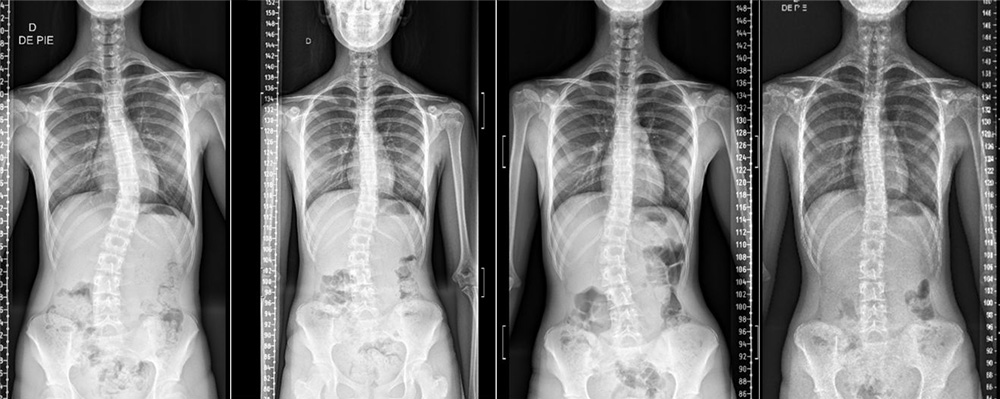
X-rays show how Matilde's spine straightens over the course of treatment in just over a year of wearing the LOC Scoliosis Brace
Treatment type: LOC Scoliosis Brace, Cheneau-Gensingen brace, Schroth therapy
Harriet, diagnosed with scoliosis at 10 years old, was initially recommended spinal surgery. Harriet's parents, sceptical about surgery, researched alternatives and discovered the London Orthotic Consultancy (LOC).
Undergoing non-surgical treatment, Harriet wore a Cheneau-Gensingen brace from a previous supplier for 23 hours a day before graduating to a LOC Scoliosis Brace. She found attending scoliosis physiotherapy sessions helpful, particularly the support and camaraderie with other teenage patients in braces.
Harriet's dedication to wearing the brace and the exercise regime resulted in a significant curve reduction, from a 42-degree to a 5-degree curve. She continues to wear the brace at nighttime.
Read Harriet’s scoliosis bracing story
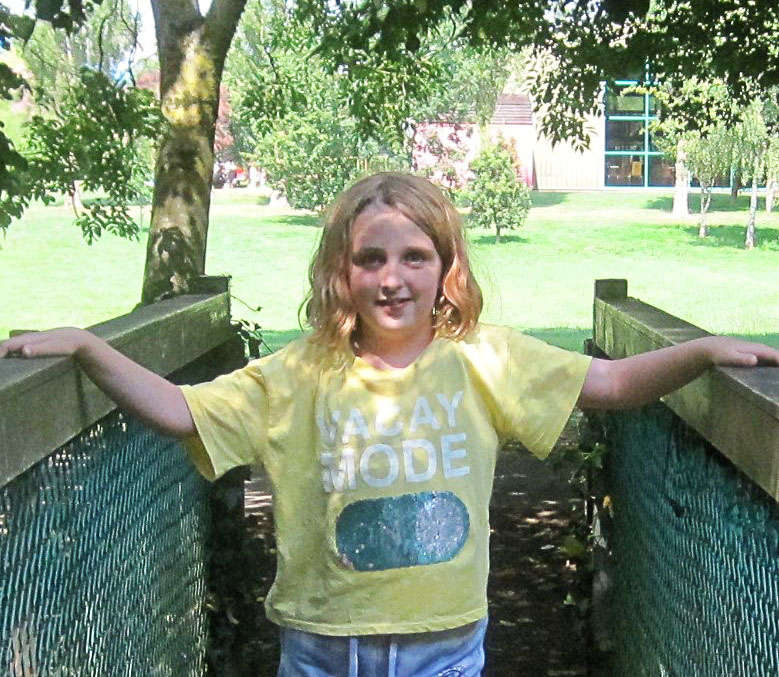
Harriet wearing her LOC Scoliosis Brace under her t shirt
Treatment type: LOC Scoliosis Brace, Schroth Physiotherapy
Flo was diagnosed with adolescent idiopathic scoliosis at 12 years old. She experienced a rapid increase in her 16-degree Cobb angle during a growth spurt, causing her Cobb angle to increase to 34 degrees.
Despite the hospital's initial reluctance to brace, Flo came to see us following an initial free virtual consultation with lead scoliosis clinician Anna Courtney.
After 16 months of wearing her bespoke LOC Scoliosis Brace, Flo's spine straightened and her Cobb angle reduced to zero degrees.
Mum Vicky emphasises the importance of timely intervention in scoliosis treatment and says, “My obvious, only regret is that we didn’t start bracing with LOC earlier.”
Read Flo’s scoliosis bracing story
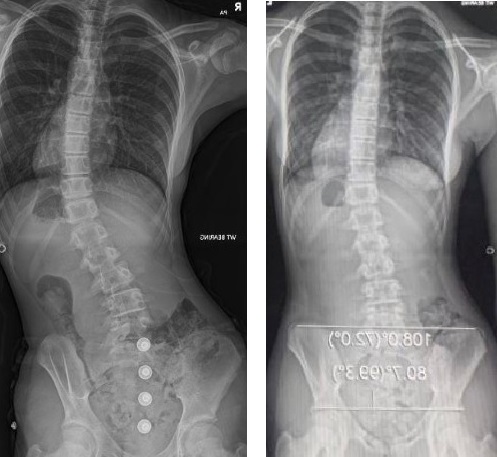
Flo's x-ray results before and after treatment with the LOC Scoliosis brace
Treatment type: Cheneau-Gensingen brace and LOC Scoliosis Brace, Schroth Physiotherapy
Sofia, now 19, successfully completed bracing treatment with the London Orthotic Consultancy in 2023 for her adolescent idiopathic scoliosis. Diagnosed with a 40-degree Cobb angle, surgery was initially recommended, but Sofia and her mother, Elena, sought an alternative with the LOC Scoliosis Brace.
Despite initial challenges, Sofia adapted to the brace-wearing regime, gradually reducing her wear time from 22 to 8 hours a day. After a year without the brace, her spine remains stable, eliminating the need for surgery.
Read Sofia’s scoliosis bracing story
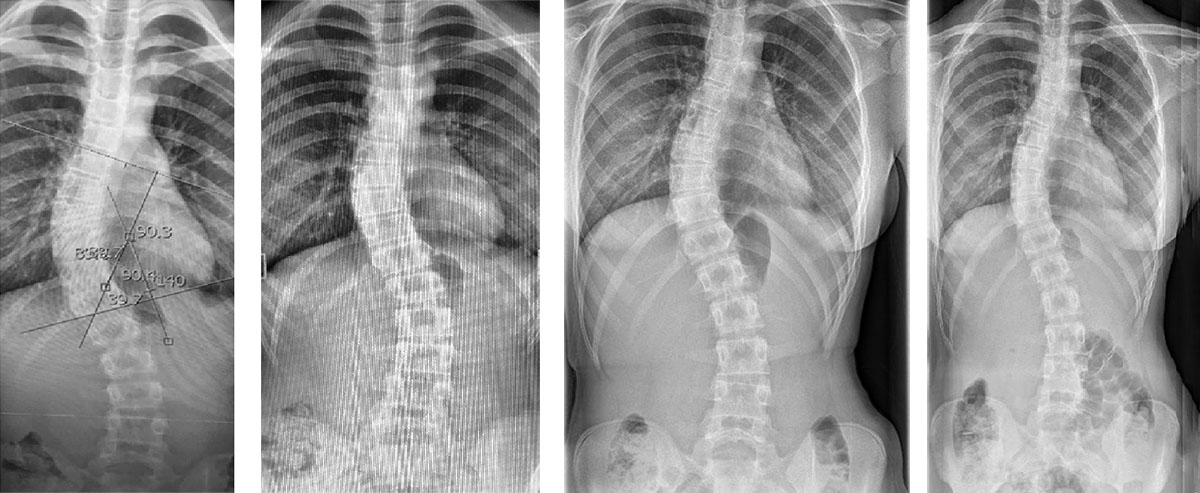
Sofia's x-rays show her spine straightening over time and her Cobb angle reducing while wearing the LOC Scoliosis Brace
Treatment type: LOC Scoliosis Brace, Schroth Physiotherapy
11-year-old patient, Benjamin, from the Philippines, came to us with a severe, right-sided thoracic curve with a Cobb angle of 49 degrees. Our same-day service for scoliosis bracing provided the perfect solution for the family.
Benjamin was assessed and fitted on Monday, reviewed Tuesday, had his in-brace data collected alongside an EOS x-ray on Wednesday before his final brace adjustments completed on Thursday.
Read Benjamin’s scoliosis treatment story
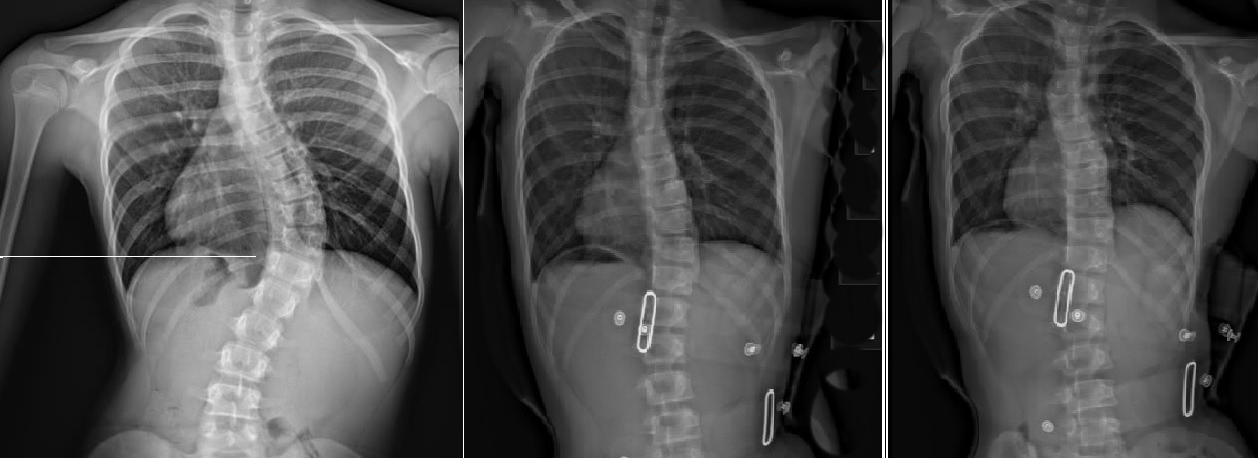
Benjamin's x-rays show his spine straightening over the course of treatment. with the middle and right x-rays showing the in-brace correction achieved with the LOC Scoliosis Brace.
Treatment type: LOC Scoliosis Brace, Schroth Physiotherapy
Alex first came to LOC at 13 years old, with a generalised thoracic lumbar curvature convex to the right, and a Cobb angle of 22 degrees.
An additional challenge was that Alex has type 1 diabetes, so to make his scoliosis brace fit comfortably, we had to change its design significantly, creating a custom, one-of-a-kind brace that could work with his insulin pump.
After just 6 weeks of bracing, in-brace data collection showed his curve overcorrecting to -5 degrees.
Read Alex’s scoliosis bracing story
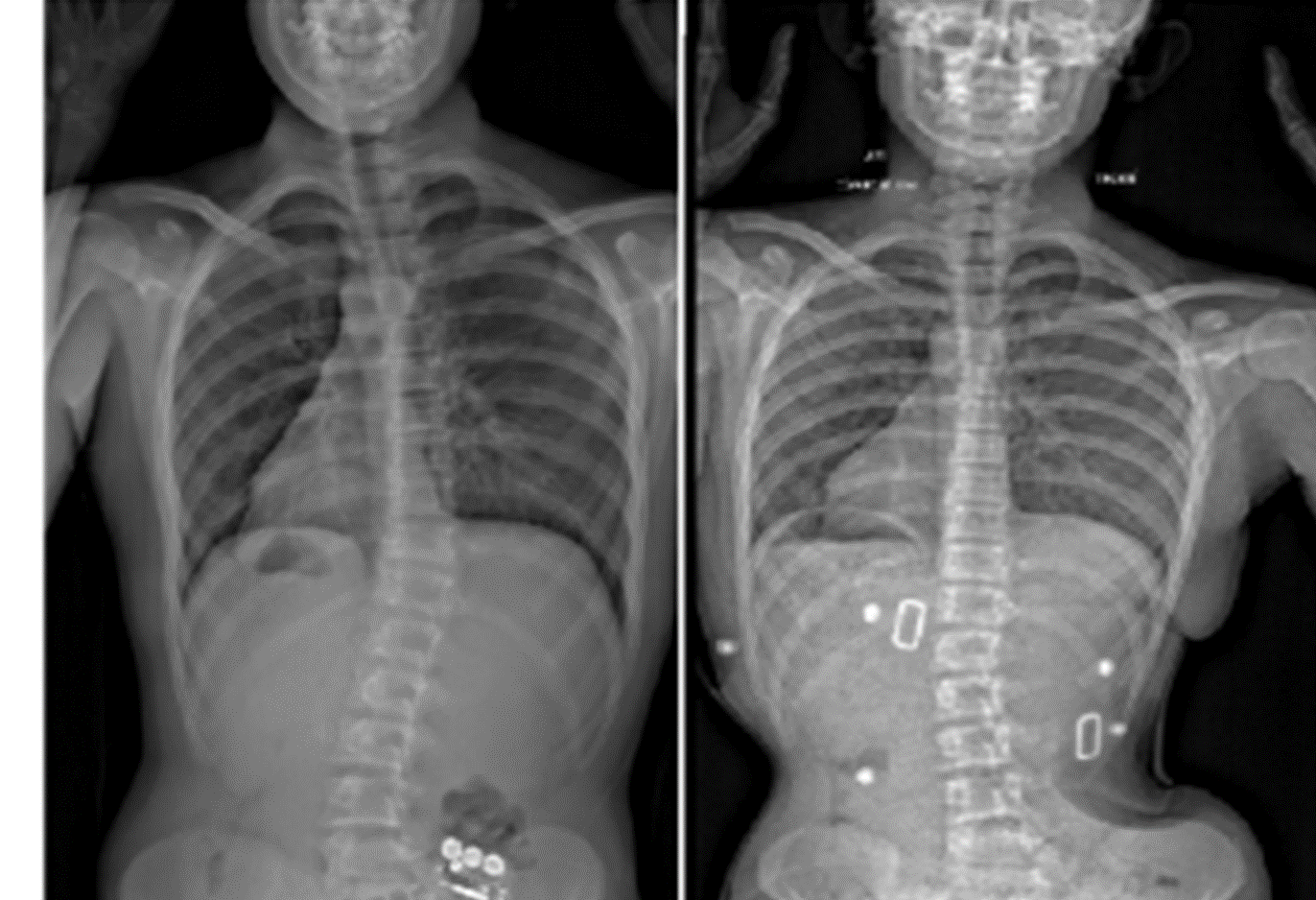
Treatment type: Cheneau-Gensingen brace, Schroth Physiotherapy
One of our three-year-old patients with infantile idiopathic scoliosis. He first came to us with a single thoracic curve with a Cobb angle of 30 degrees and he was hypermobile. He was fitted with a bespoke orthotic brace and had custom foot orthotics fitted to aid with his hypermobile pes planus (flat feet) too.
After five months of full-time wear and Schroth physiotherapy, his Cobb angle had gone down to 22 degrees. Seven months of part-time wear afterwards meant that his Cobb angle decreased again to 17 degrees. He responded to bracing treatment incredibly well and is currently wearing it for 23 hours a day, even at preschool.
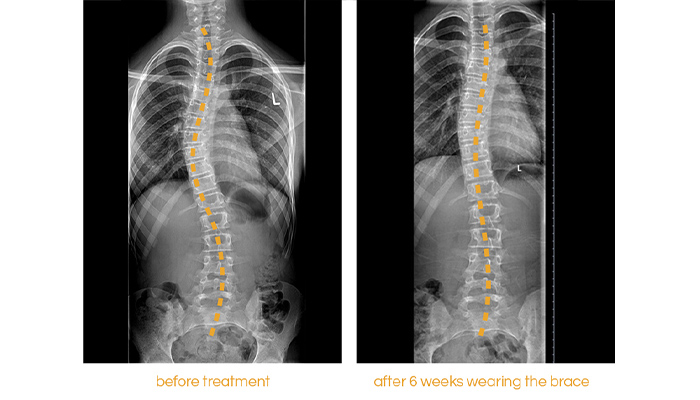
Treatment type: Cheneau-Gensingen brace, Schroth Physiotherapy
One of our international, infantile scoliosis patients from Bahrain, who was two-years-old when she came to LOC. Her primary curve reduced from 44 to 27 degrees in four months. On the left, you can see her first brace fitting, and on the right, her second brace fitting.
With international patients we try to arrange appointments as often as possible – as close to once every three months as possible, as recommended. We spend time with parents to ensure they know how the brace is fitted and how to make minor adjustments.
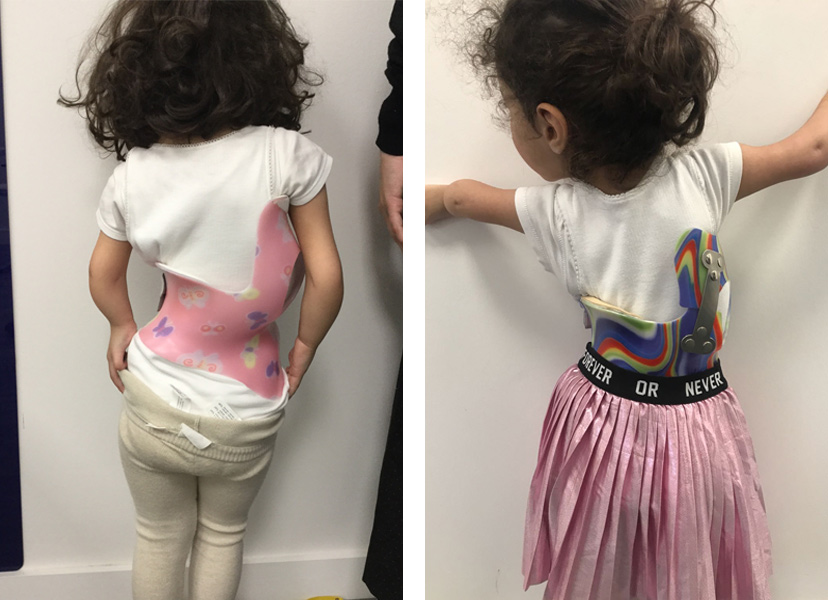
Treatment type: Cheneau-Gensingen brace, Schroth Physiotherapy
When this female juvenile scoliosis patient came to LOC at the age of six, she had a single thoracic curve with a 30-degree Cobb angle. She had a bespoke Cheneau-Gensingen brace fitted and after two months of full-time wear and a further four months of 18-hour-per-day wear with Schroth physiotherapy, out of brace X-Ray showed that her Cobb angle had reduced from 30 to 5 degrees. Now out of the brace, but continuing with Schroth physiotherapy, her most recent review revealed that her curve was stable and had not regressed.
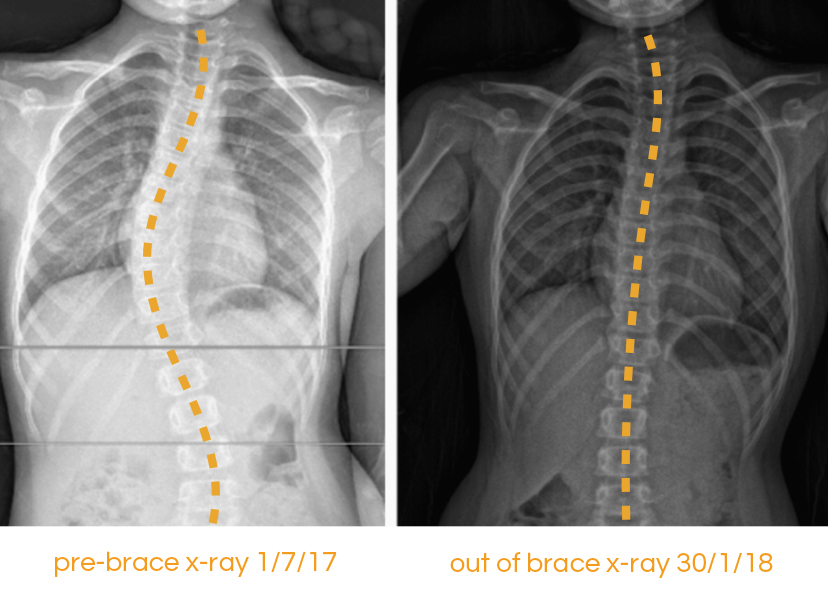
Treatment type: Schroth Physiotherapy
This seven-year-old juvenile scoliosis patient has been completing a home exercise program with her parent's support after three sessions of Schroth-Based Physiotherapy and is following extension sports advice. We continue to support the family to monitor the patient and review every six to eight weeks – her parents have commented on her improved posture and rib hump.
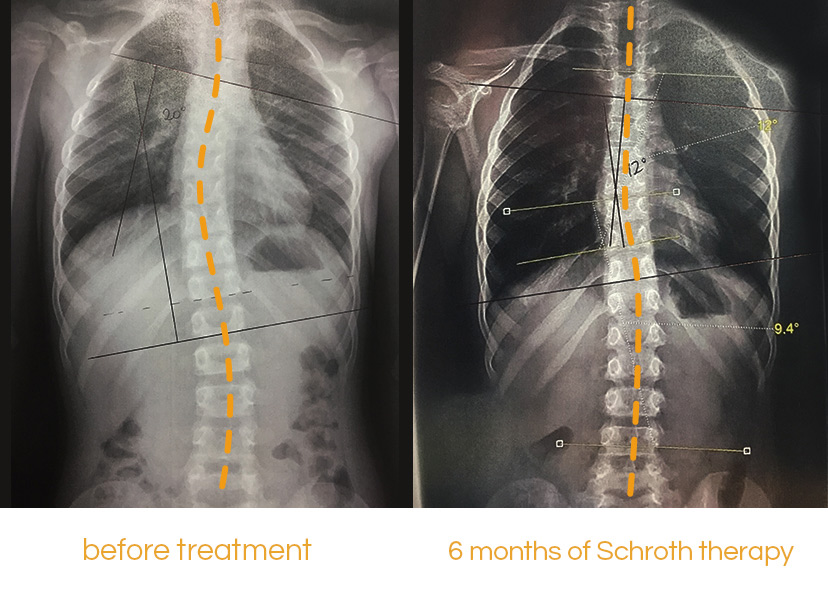
Treatment type: Cheneau-Gensingen brace, Schroth Physiotherapy
One of our 14-year-old adolescent scoliosis patients started to notice her back change during a rapid growth phase. She had a thoracic curve of 35 degrees and was referred by a specialist for a spinal brace to manage this conservatively. After six weeks of wearing a bespoke Cheneau-Gensingen Brace, her in-brace curve had reduced to 12 degrees.
She was also experiencing some rotation of her thoracic curve, which measured 13 degrees. After six weeks, this had reduced to 8 degrees out of the brace. Postural improvements are visibly noticeable from the above photo. She continues to wear the brace to seek further improvement.
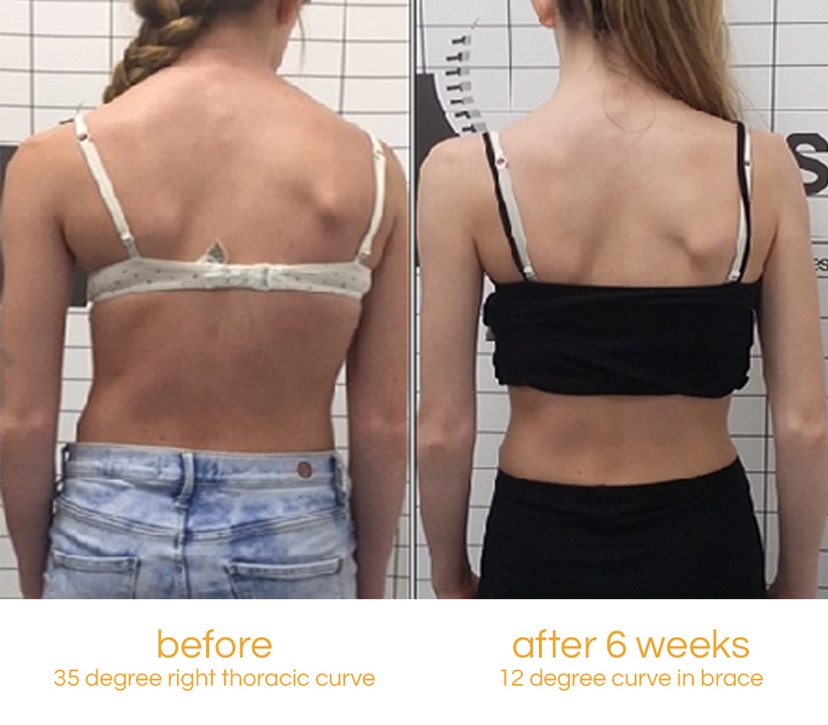
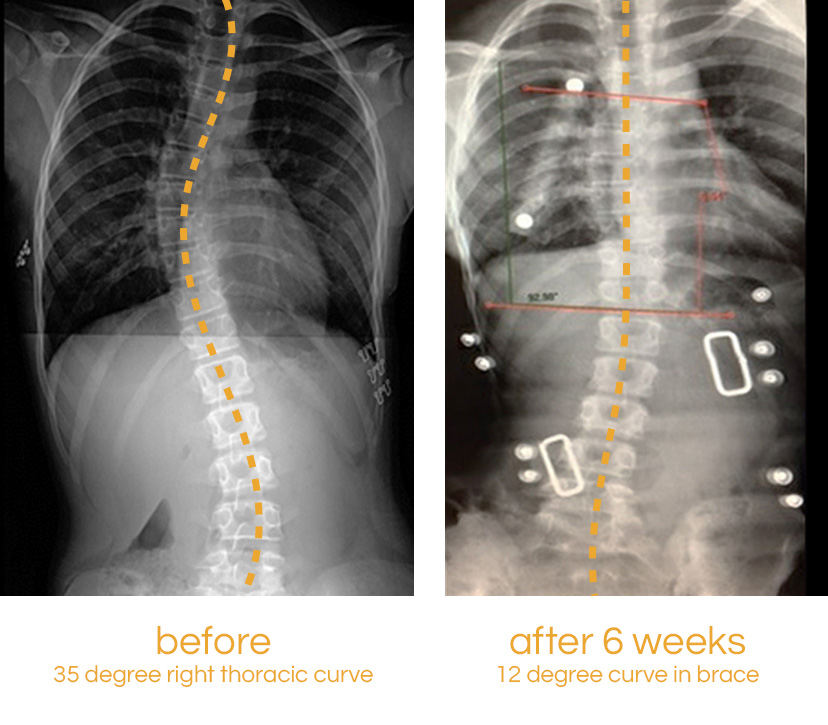
Treatment type: Cheneau-Gensingen brace, Schroth Physiotherapy
We featured Ricarda in a blog post discussing her scoliosis treatment. She had a 30-degree Cobb angle and three twists when she initially visited the London Orthotic Consultancy.
After only six weeks in the brace, X-rays were again taken of Ricarda’s spine and showed a visible reduction in the shape; going from a 30-degree thoracic curve to 5 degrees in-brace. Her out of brace X-Rays reveal that her thoracic curve decreased from a 30-degree Cobb angle to 26 degrees and her lumbar Cobb angle decreased from 20 degrees to 16 degrees.
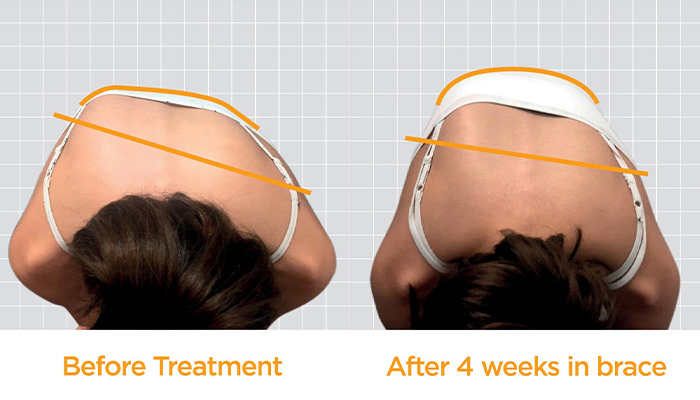
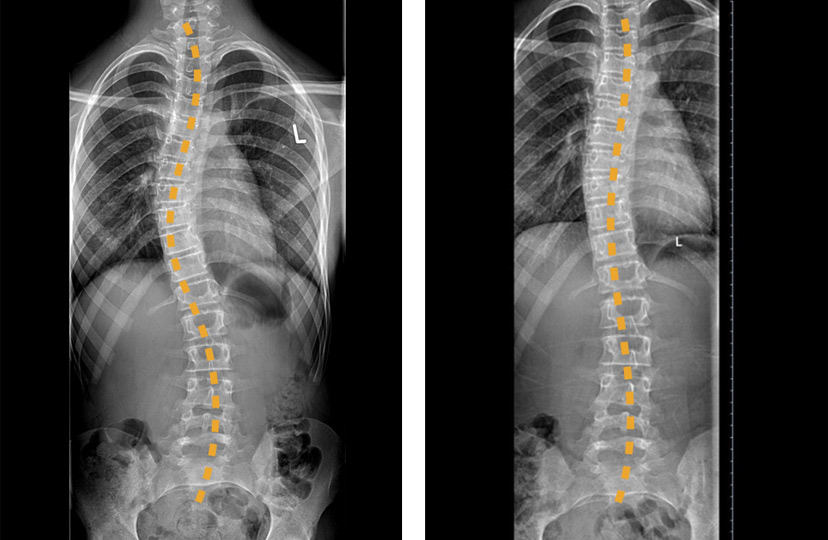
Before and after bracing treatment
Treatment type: Cheneau-Gensingen brace, Schroth Physiotherapy
Angelina is a thirteen-year-old scoliosis patient who had a bespoke Cheneau-Gensingen brace fitted. Prior to treatment, Angelina had a thoracolumbar Cobb angle of 40 degrees. After six weeks of wearing the brace, her curve had reduced to 31 degrees. You can read her full story in our blog post about Angelina’s scoliosis success.
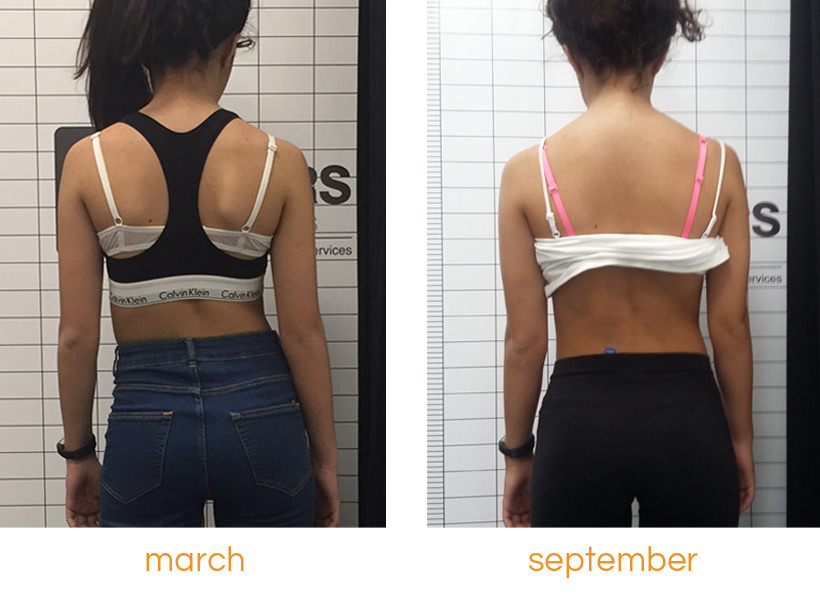
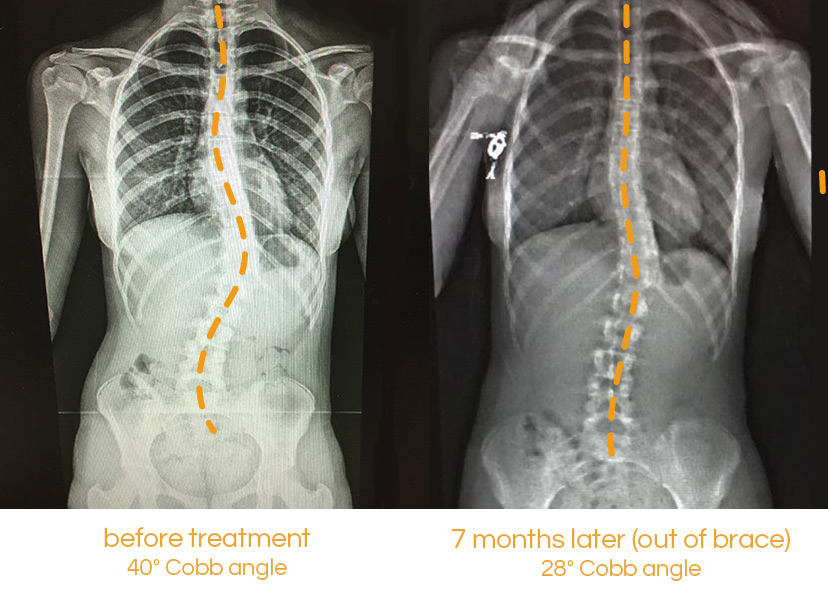
Treatment type: Cheneau-Gensingen brace, Schroth Physiotherapy
12-year-old Rares came to us with Cobb angles of 52 and 24 degrees and participated during our Scoliosis Open Day. After having his bespoke Cheneau-Gensingen brace fitted, in just two months his Cobb angle reduced from 52 to 24 degrees in-brace, his ribcage de-rotated from 18 to 12 degrees and his rib hump significantly improved. You can read his full story in our blog post detailing his scoliosis treatment.
After ten months in total, Rares continues to progress with his bracing treatment. After wearing his first Cheneau-Gensingen brace for 10 months, his out-of-brace X-rays (photos below) reveal that his thoracic curve Cobb has reduced from 52 to 35 degrees, with his lumbar curve also reduced from 20 to 17 degrees. He is now in his second brace which will hopefully see his results improve even further.
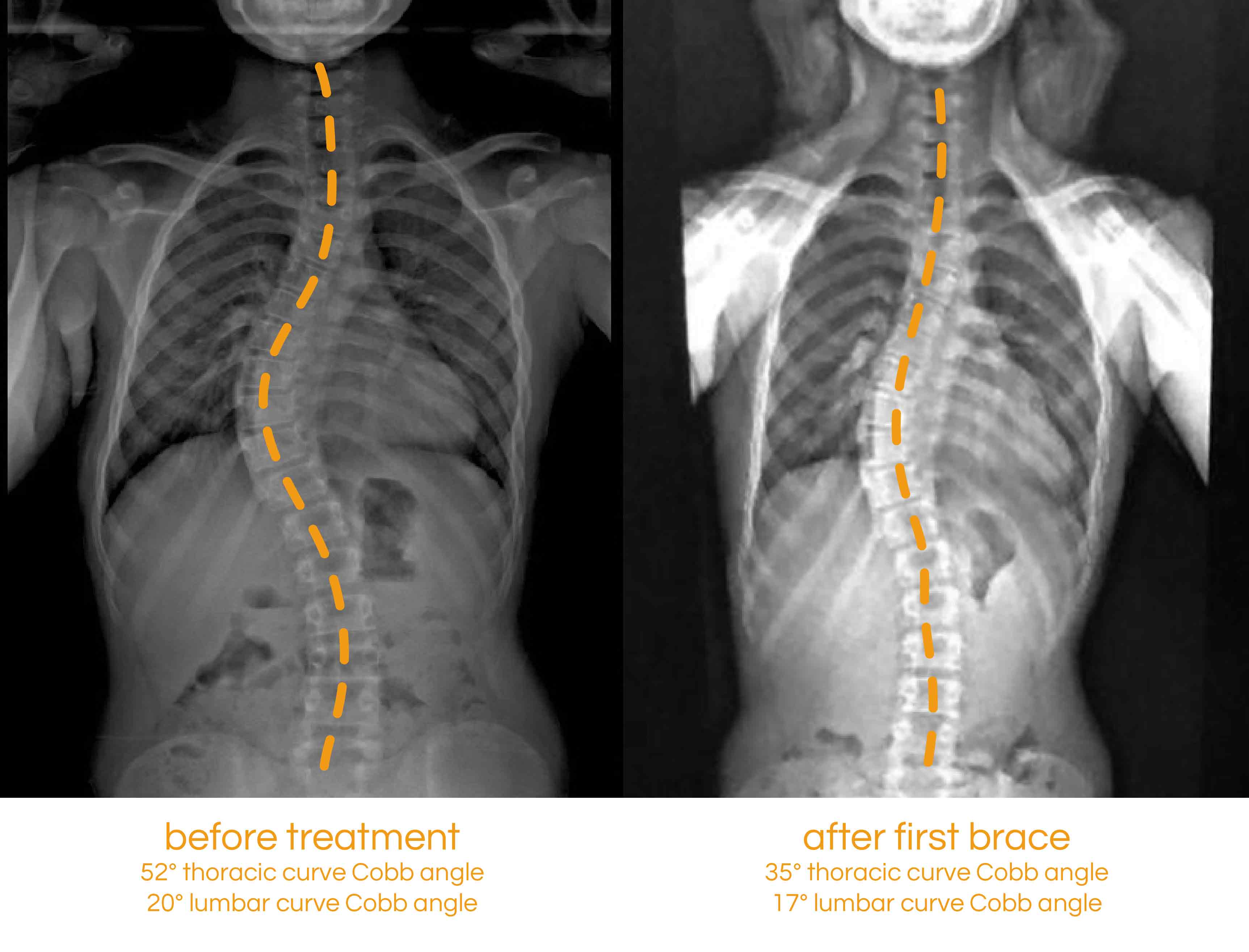
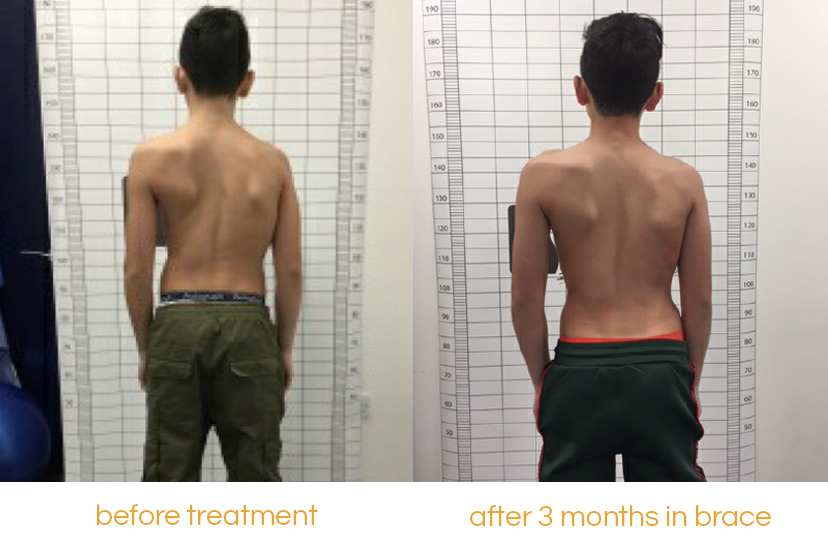
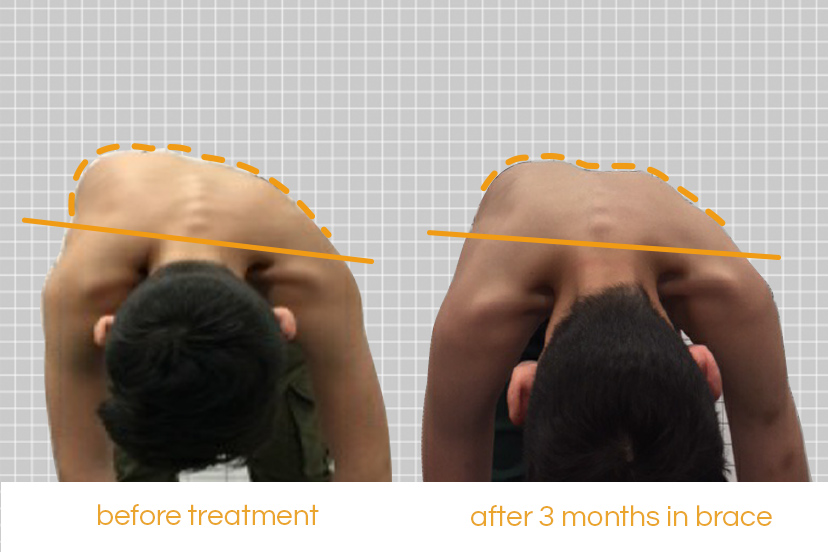
Treatment type: Cheneau-Gensingen brace, Schroth Physiotherapy
Within two months of starting Cheneau-Gensingen brace treatment, this 12-year-old adolescent scoliosis patient’s ribcage derotated from 12 degrees to 8 degrees and her Cobb angle reduced from 18 and 28 degrees to 0 and 5 in-brace.
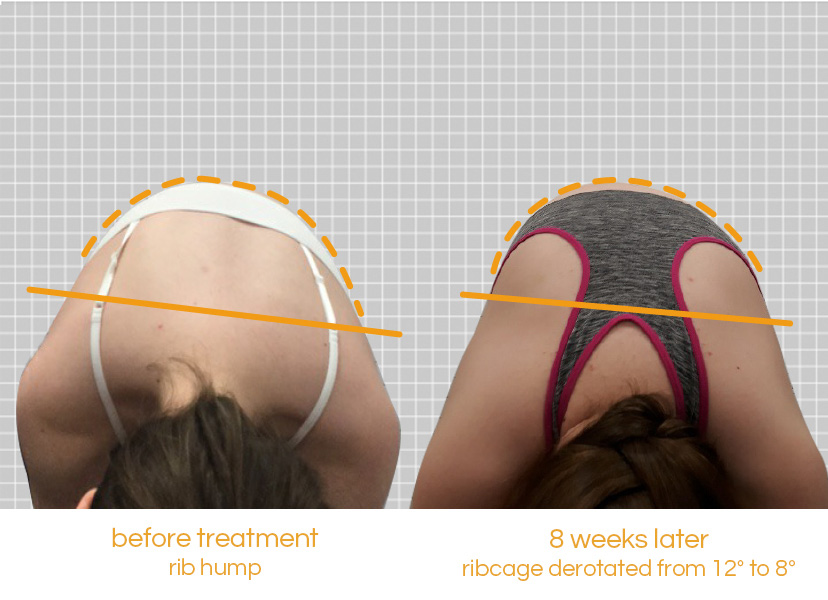
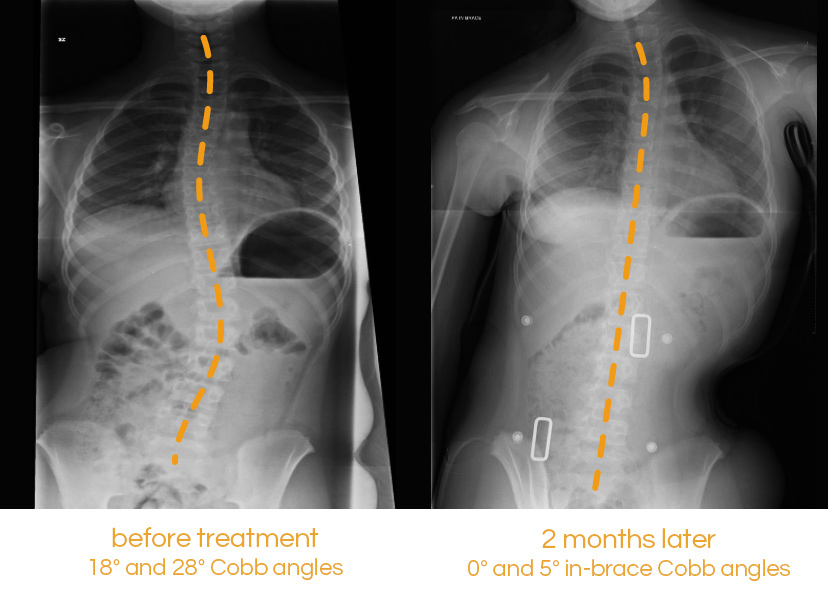
Treatment type: Cheneau-Gensingen brace, Schroth Physiotherapy
This 14-year-old patient came to LOC with Cobb angles of 28 and 30 degrees, which, after her six to eight-week review reduced to 0 and 13 degrees in-brace.
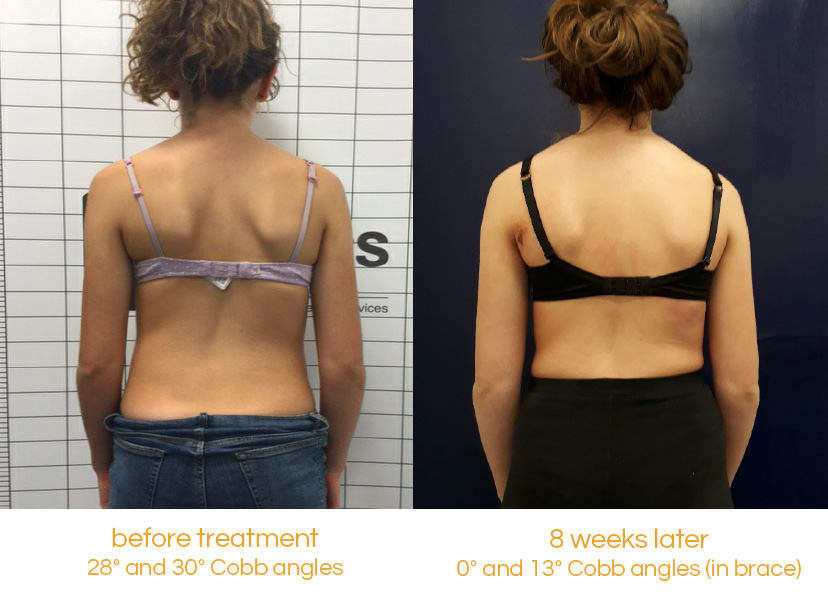
Treatment type: Cheneau-Gensingen brace, Schroth Physiotherapy
Sinead is one of our successful adult scoliosis patients who has experienced scoliosis-related back pain since her twenties. Since starting a course of Schroth based physiotherapy course and wearing a bespoke Cheneau-Gensingen spinal brace, her rib cage has de-rotated from 16 to 8 degrees, has halted progression and she reports her pain is reduced.
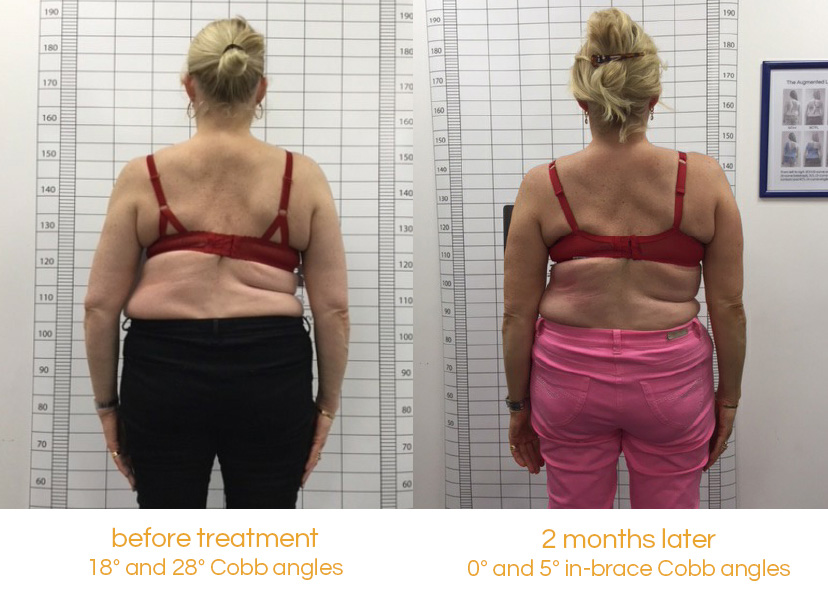
The operation used to treat severe scoliosis curves is typically spinal fusion surgery; a major procedure that involves moving muscles and realigning the skeleton into place. The curved, deformed vertebrae are fused together into a single bone, putting metal screws and rods into the spine to help straighten it. Surgery typically lasts between 4 and 8 hours depending on the severity of the curve. Bone graft is then taken from other parts of the body and used to cover the implants.
Following the operation, it is necessary to spend around a week in intensive care before returning home and the first few days are often uncomfortable. Most adolescents can expect to return to school from 2-4 weeks following surgery, but pain medication may be required up to 6 weeks following. A full recovery from the procedure can take up to a year, as it can take that long for the spine to heal fully.
Spinal fusion surgery causes the fused portion of the back to become permanently stiff, as a result, returning to sports that require large amounts of flexibility (ballet, yoga, gymnastics, dance) or contact (rugby, football, karate, hockey) may take longer.
Risks of spinal fusion surgery are like that of any other major procedure and include infection, blood clots and anaesthesia complications. The added risks include permanent nerve damage to the spine and paralysis.